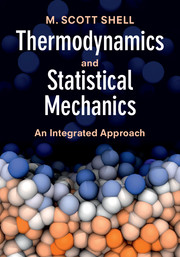Book contents
- Frontmatter
- Contents
- Preface
- Reference tables
- 1 Introduction and guide for this text
- 2 Equilibrium and entropy
- 3 Energy and how the microscopic world works
- 4 Entropy and how the macroscopic world works
- 5 The fundamental equation
- 6 The first law and reversibility
- 7 Legendre transforms and other potentials
- 8 Maxwell relations and measurable properties
- 9 Gases
- 10 Phase equilibrium
- 11 Stability
- 12 Solutions: fundamentals
- 13 Solutions: advanced and special cases
- 14 Solids
- 15 The third law
- 16 The canonical partition function
- 17 Fluctuations
- 18 Statistical mechanics of classical systems
- 19 Other ensembles
- 20 Reaction equilibrium
- 21 Reaction coordinates and rates
- 22 Molecular simulation methods
- Index
- References
22 - Molecular simulation methods
Published online by Cambridge University Press: 05 April 2015
- Frontmatter
- Contents
- Preface
- Reference tables
- 1 Introduction and guide for this text
- 2 Equilibrium and entropy
- 3 Energy and how the microscopic world works
- 4 Entropy and how the macroscopic world works
- 5 The fundamental equation
- 6 The first law and reversibility
- 7 Legendre transforms and other potentials
- 8 Maxwell relations and measurable properties
- 9 Gases
- 10 Phase equilibrium
- 11 Stability
- 12 Solutions: fundamentals
- 13 Solutions: advanced and special cases
- 14 Solids
- 15 The third law
- 16 The canonical partition function
- 17 Fluctuations
- 18 Statistical mechanics of classical systems
- 19 Other ensembles
- 20 Reaction equilibrium
- 21 Reaction coordinates and rates
- 22 Molecular simulation methods
- Index
- References
Summary
Throughout this text we have presented a molecular foundation for the principles of thermodynamics that has considered many highly simplified molecular models of a variety of systems, including idealized gases, solutions, polymers, and crystals. It might not be immediately obvious how we extend these ideas to more realistic models that, for example, might entail structured molecules with complex potential energy functions including bonded, electrostatic, and van der Waals energies all at once. Even the seemingly simple task of developing the thermodynamics of a monatomic fluid at high densities, such as liquid argon, can be challenging owing to the difficulty of treating the detailed pairwise interactions in the configurational partition function.
Two routes enable one to move beyond the general statistical-mechanical considerations of Chapters 16–19 to solve molecular models of nontrivial complexity. The first is the large collection of mathematical approximations and conceptual approaches that comprises the framework of statistical-mechanical theory. These techniques often give closed-form but approximate analytical expressions for the properties of a system that are valid in certain limits (e.g., the high-density one), or, alternatively, sets of equations that can be solved using standard numerical tools. The particular approaches are usually system-specific because they hinge on simplifications motivated by the physics of the interactions at hand. We will not discuss this body of work in any detail, but refer the reader to the excellent introductory texts by Hill and McQuarrie.
- Type
- Chapter
- Information
- Thermodynamics and Statistical MechanicsAn Integrated Approach, pp. 444 - 469Publisher: Cambridge University PressPrint publication year: 2015

